thats just bad engineering.... missed sales opertunity as well as additional development cost.
Better opportunity for you RD
thats just bad engineering.... missed sales opertunity as well as additional development cost.
Better opportunity for you RD
To date....
Waiting....
SlingShade is by far the lowest profile top to date, it actually sits below the roll hoops! The side profile looks good.
Looks like the "new" color this year is Sunset Red, a deeper, richer red than the Red Pearl. Also looks like you get less painted parts in your stock unit, i.e. Lower Hoop Accents and Interior Accents. I have already seen Slingshots with the unpainted Lower Hoops on the lots. In reality they already raised prices with unpainted parts.
I'm liking the Sunset Red but not enough to trade and starting over.
Home / Motorrad / BMW Titan Motorcycle Concept
BMW Titan Motorcycle Concept
Motorrad | July 23rd, 2016 by Mike DeAmicis0

Recently, the nation of Turkey has been in the headlines, due to a myriad of events which occurred within it. Though, the country has suffered …
Recently, the nation of Turkey has been in the headlines, due to a myriad of events which occurred within it. Though, the country has suffered some destabilizing setbacks in recent weeks, today we have something quite beautiful and positive to share with you, which comes from the illustrious country.
Dubbed the Titan, this futuristic motorcycle concept depicts a rather wonderful future for our beloved motorcycle brand, BMW. Turkish designer, Mehmet Erdem, has created several BMW motorcycle concepts in the past. And, though, the rest were also impressive, the Titan is arguably his best work yet. Based in Istanbul, Erdem has created no less than seven other captivating BMW motorcycles, which all exhibit a unique and authentic interpretation of the brand.

The folks at HighSnobiety.com have reported that the inspiration for the vehicle’s shape was a shark. Also, they noted that the Titan appears to be rather fitting for Batman. Surely, if this vehicle were to ever be produced, it would be something which Bruce Wayne may consider upgrading to, due to its radical design and probable performance capabilities. Sadly, this design exercise will almost certainly never transition from the conceptual stage to reality. Still, Erdem’s design can serve to inspire manufacturer’s designers to take greater risks, to design truly dramatic and mesmerizing motorcycles.
Visit the Author on Instagram @MikeAndHisBikes
BMW Titan MotorcycleMotorrad
I would first get a warranty claim in through your dealer and get replacements coming from Polaris, this costs you nothing but your time. If in the meantime you find replacements on your own you could elect to change them out yourself for safety's sake. Be sure to come back here and post if you find replacements.
I believe @Tango and @Cameron Roberts are waiting for ball joint replacements. Maybe they could chime in.
By James Parker Yesterday at 11:27pm

Renault motorsport
Renault’s KERS engine uses an electric motor to spin up the turbo, unlocking serious low-end power. Would a similar system work on a motorcycle?
After I worked on the chassis design for the Mission R electric bike, I decided to look at the possibility of a “hybrid” motorcycle. Most hybrid vehicles have two drive systems—internal combustion and electric—and on motorcycles this imposes serious weight and packaging compromises. At this point, I don’t think conventional hybrid motorcycles would be very good.
But there’s another hybrid technology under development that could work well to create very interesting high-performance motorcycles. Starting in 2009, Formula 1 car racing allowed a hybrid system that provided supplemental horsepower, called KERS (Kinetic Energy Recovery System). Electrical (or mechanical) energy generated under braking is stored and then used to provide additional power under acceleration for short periods.
In 2014, a second hybrid element was introduced. In addition to the KERS motor/generator, there is now a second motor/generator, this one attached to the engine’s turbocharger. Under deceleration, when reduced exhaust flow reduces turbo speed, this motor spins up to maintain turbo rpm and keep boost near maximum. Turbo lag, the time needed for turbos to speed up enough to provide boost, has always been the turbo’s weak point. The new hybrid application virtually eliminates it.
At high engine and turbo revs, the electric motor attached to the turbo becomes a generator, generating electricity while working to slow the turbo and thus limit boost from becoming destructive to the engine. (A conventional wastegate is also used as a backup.) The electricity charges the battery for when the motor needs to keep the turbo’s speed up (or to help with the KERS energy distribution).
The illustration shows the Renault F1 battery (left), engine (center), and turbo (right). Nested in the engine’s vee is the turbo’s motor/generator, called the MGU-H by Renault.
Will we see such a system on motorcycles soon? Probably not, as the F1 setup is astronomically expensive. But there’s another version, using parallel ideas, that’s closer to production—the Volvo High Performance Drive-E Concept.
This engine is a 2-liter inline-four, with two small, conventional, exhaust-driven turbos mounted close to the exhaust ports for best efficiency. There’s also a third turbo (or at least the compressor half), but this one is exclusively electrically driven to eliminate turbo lag when the engine is at low revs and the exhaust-driven turbos would not be providing enough boost.
How well does it work? It makes 450 hp from 2 liters and has the bottom-end torque it needs to pull a heavy car around. What would something like this look like in, say, a Yamaha FZ-07? Although its engine is less than half the displacement of the Volvo project, mechanically it’s much like half of the Volvo with its two cylinders, two cams, and four valves per cylinder. It would get one small exhaust-driven turbo and a smaller version of the Volvo electrically driven turbo. Add an intercooler and various upgrades to take the additional power and we’d have a little superbike.
At the power-per-displacement number of the Volvo, the little 689cc “FZE-07” would put out 155 hp and would likely have significantly more bottom-end torque than any literbike.
The lesson here is that this alternative hybrid technology can liberate turbocharging from its dependence on exhaust flow and engine rpm and do for bottom-end power what turbocharging has always done for top-end power. We can perhaps see the super-efficient F1 approach to hybrid turbocharging as the preferred future system, but Volvo has shown that we don’t have to wait to take that approach—we can have a workable system now.
Audi is also working with turbo company Valeo on what they call an electric supercharger. With Audi’s involvement with Ducati, would that be a possible route to seeing hybrid turbos on motorcycles? Interesting times ahead.
Another recent article, seems as though Polaris is getting some coverage
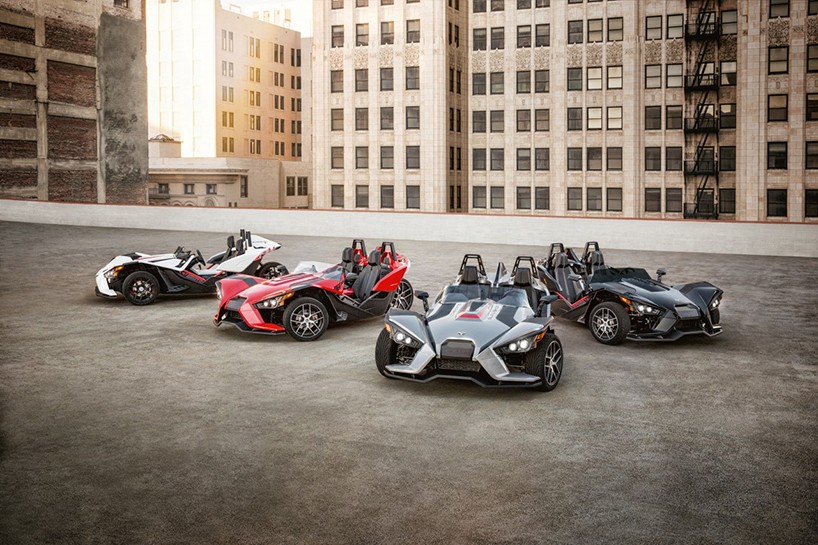 jul 22, 2016
jul 22, 2016
polaris 'slingshot' combines motorcycle spirit with the functionality of a car
97
58
23
8
polaris ‘slingshot’ combines motorcycle spirit with the functionality of a car
polaris have broadened the appeal of its adrenalin-packed three-wheel roadster in europe, with the introduction of new color schemes plus two limited edition models.
video courtesy of polaris slingshot
following its introduction to europe at the end of 2015, the design has carved its own niche with enthusiasts already, where the outlandish looking ‘reverse trike’ has, up until now, only been available is its red launch colour. drawing influence from its USA homeland, where it has developed a fast-paced cult following, customers in europe now get greater choice with a new ‘turbo silver’ colored ‘SL’ version plus a further two limited edition ‘pearl’ models.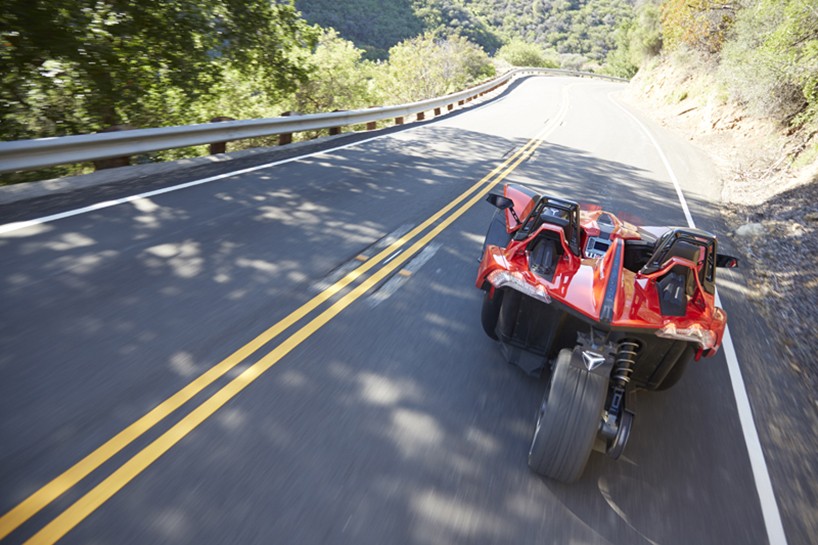
regardless of specification chosen or trim level, slingshot as standard features: a low, wide stance allowing drivers to feel the rush of the road under their seat; an open-air cockpit with a 360-degree rush of sight, sound and smell; a shared riding experience, giving driver and passenger a front-row shot of adrenalin; optimised weight distribution and proprietary low-profile tires for maximum cornering; lightweight design for powerful acceleration.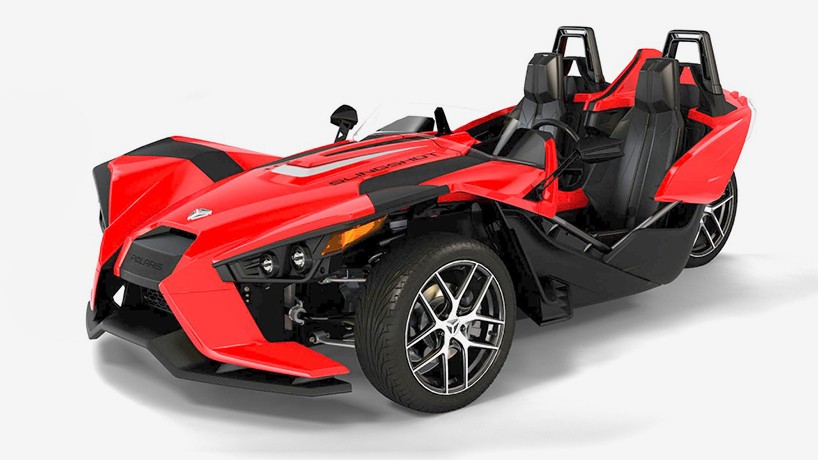
‘since we launched ‘slingshot’ in europe at the end of 2015, our dealers have reported a growing trend for customization’, commented grant bester of polaris EMEA. ‘it will come as no surprise that slingshot customers like to stand out from the crowd, so we’ve gone one step further now in europe, by launching a new additional color for the sl model and two new limited edition models also’.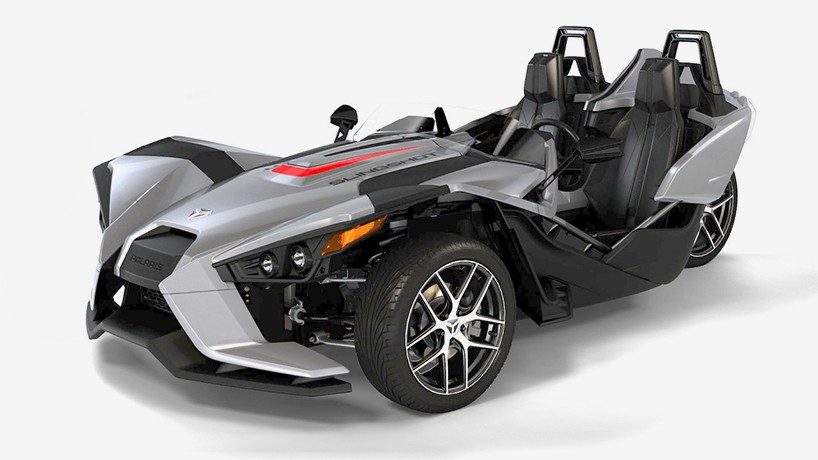
slingshot’s 2016 european line-up now looks like this:
slingshot ‘SL’ — available in both ‘pearl red’ and ‘turbo silver’ colour options. now features new all-black seats and bold new graphics; slingshot ‘limited edition’ — available in ‘black pearl’ and ‘white pearl’ colour options. features the ‘SL’ specification as standard, plus — indy red powder coated frame, swing arm, springs, front-arm suspension, tinted wind deflector, interior lighting kit and blacked-out cast aluminum wheels.
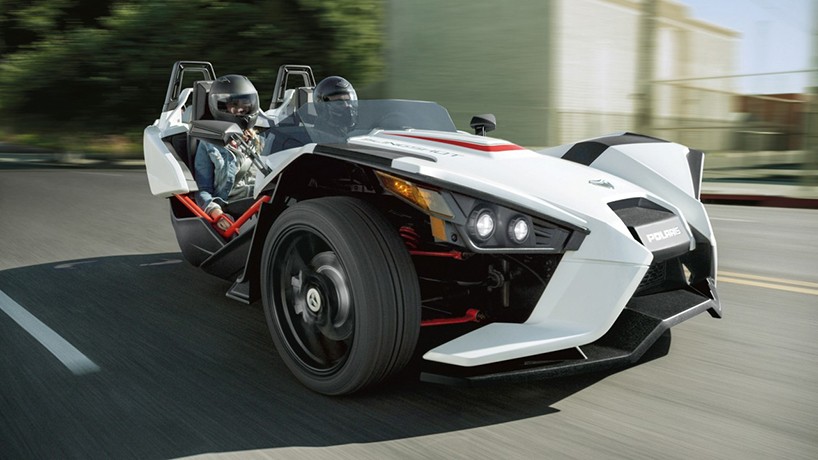
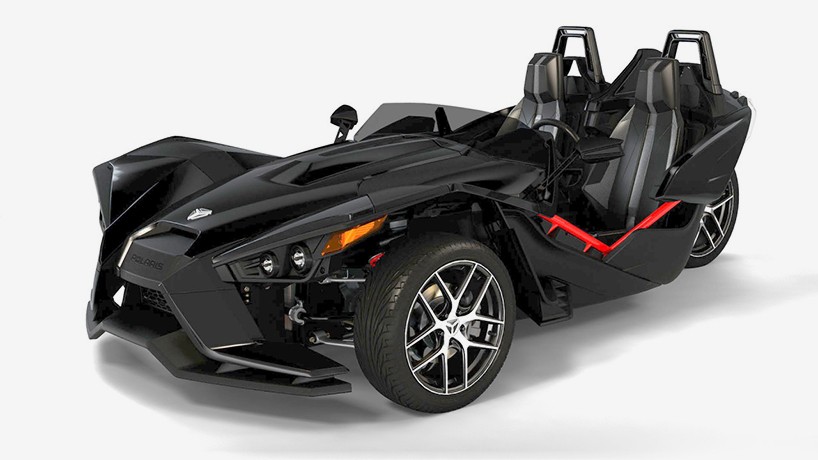
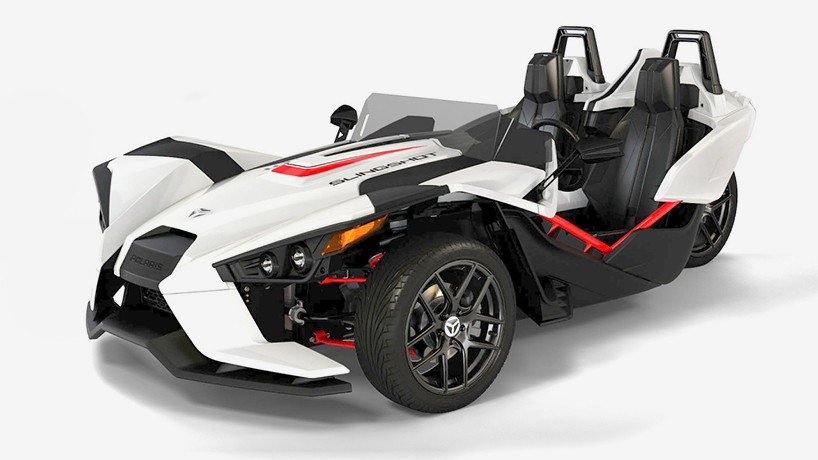
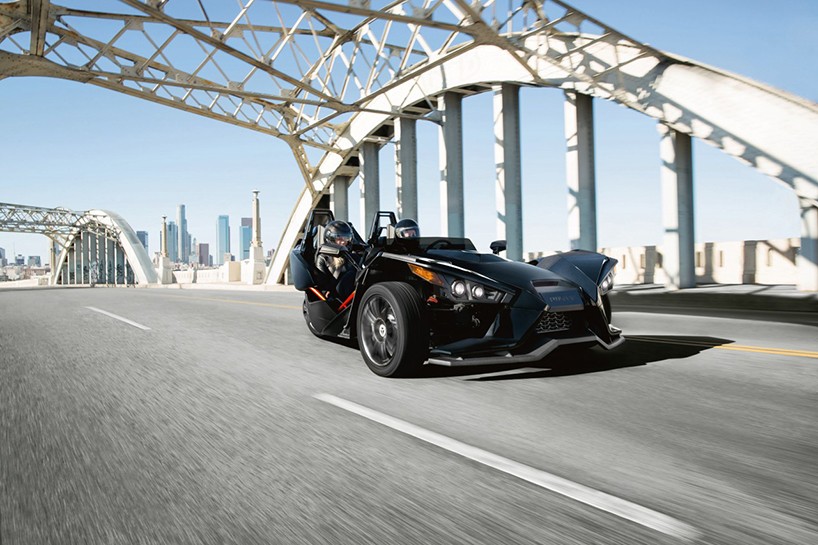
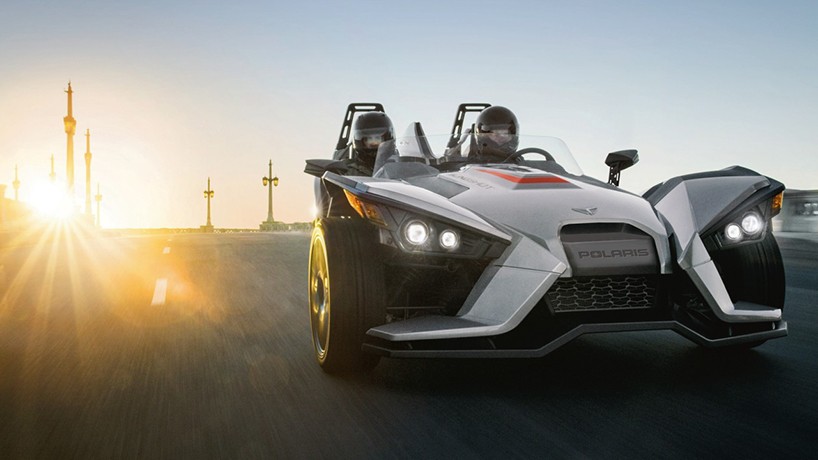
Recent article seems unbiased and honest,
Review: Polaris Slingshot aims at the gap between car and motorcycle
Aaron Heinrich July 21, 2016
16 PICTURES
It's easy to see from this angle why the Slingshot brings the Batmobile to mind (Credit: Aaron Heinrich / Gizmag) View gallery (16 images)
When Polaris unveiled the Slingshot in 2014 as a 2015 model, even the company itself was hard-pressed to categorize it. So much so that some states wouldn't let it be licensed until Polaris worked with them to either define a new category, which became autocycle, or allowed it to be licensed as a motorcycle. Either way, no one then or since has denied just how different this vehicle is.
Visually, there's no way anyone's going to confuse the Slingshot with a motorcycle. That long hood, two wheels up front, side-by-side seats, and steering wheel are dead giveaways.
But it's also not a car. The lack of side doors, a trunk, any kind of top, no safety features – other than three-point seat belts and individual rollbars behind each seat – and a single rear wheel leave you wondering ... what is it?
And that's probably its greatest defining feature – its ability to attract the kind of attention that makes people stop you and ask exactly that. The best response we could come up with is that it's a three-wheeled go-kart on steroids.
Powered by a 2.4-liter, inline 4-cylinder GM Ecotec engine coupled to a five-speed transmission, the Slingshot weighs in at just over 1,700 lb (790 kg). Producing a claimed 173 hp (127 kW) and 166 ft. lb. of torque (225 Nm), there's more than enough power to weight regardless of what you want to call it.
The speedo goes up to 130 mph (209 km/h), which we didn't get to, but it definitely had no problem hitting 90 mph (145 km/h) in fifth gear with plenty of room left before it would reach the 7,000 rpm redline. Braking comes via ABS, and we had no complaints there.
It takes corners like it's on rails, thanks to a double wishbone suspension and anti-sway bar upfront, as well as a 5-inch (12.7-cm) ground clearance. A generous amount of rubber doesn't hurt either. The base model comes with two 17-inch front wheels and a single 18-inch wheel in the rear, while the Slingshot SL and SL LE editions have two 18-inch forged aluminum front wheels with a 20-inch rear wheel.
We slid the back end out a couple of times trying too hard to do so, and that was with the traction control on. But chances are the average person isn't going to be coming into a controlled intersection hitting a green light at 30 mph, while trying to bank a hard left to stay in the proper lane.
We drove our demo Slingshot on freeways, neighborhood side streets, straight country roads and twisty foothill asphalt. If there wasn't a constant grin on our face, we weren't aware of it. It seemed to be equally at home anywhere we took it.
We thought that its low-to-the-ground stance would evoke some butt-thumping rides on rougher pavement, but the suspension did a nice job of evening most of it out. We also weren't expecting it to be a super-silky ride anyway.
Other features include a simple-to-use cruise control that worked as you would expect, and fairly generous storage, including a big glove compartment and locking cubicles behind each seat that are big enough for a couple of helmets or a few small bags of groceries.
This isn't to say it's not without its issues, primary of which is the extensive heat that comes up into the passenger compartment from the engine bay. A passenger wearing open-toed sandals actually got too uncomfortable, and we worked up a sweat just driving around on a warm summer day. This is definitely a problem we think Polaris should fix, either by increasing the cabin ventilation or making the firewall thicker between the engine bay and cabin.
We had the Slingshot SL model, which comes with the entertainment system and backup camera. The former also allows you to sync to your phone with Bluetooth, and pair a music player via a cable in the glove compartment. However, if the sun is shining at any kind of angle you can't see anything on that screen. That means the backup camera is essentially useless unless you're in the shade, or the sun isn't fully out.
A solution might be to put some type of visor above the screen, but we gave up trying to use the backup camera and were just really careful reversing out of parking lots and driveways.
We likewise weren't wild about the gas gauge. It consists of a series of bars across the top of the digital screen embedded in the speedometer, where you can also see your overall mileage, trip meter and related readouts. When the gas tank is full – slightly under 10 gallons (38 liters) worth – all of the bars are black. They each turn white as you drive until the low fuel light comes on.
This sounds good in theory, if you could see those bars. But again, any kind of sun shining on that part of the dash makes it nearly impossible.
We also didn't care for having to wear a helmet, despite the fact that you don't need a motorcycle license to drive a Slingshot in California. State laws vary, and the dealer where we picked up our demo said some owners have told him they've gotten tickets, so check state and local laws beforehand.
The closest vehicle you'll find to the Slingshot is the V-twin powered 3-wheeled Morgan, but at 82 hp (61 kw) and 103 ft. lb. (140 Nm) of torque, it's underpowered in comparison. It's also more expensive with a base price of US$36,000. By contrast, the base Slingshot is listed at $21,499, the SL model we tested that was stock comes in at $25,499 and the most expensive LE model starts at $26,999.
There are a few factory accessories available to add some performance and personalization, but customizers and DIY owners have already taken on the task of coming up with their own variations. We anticipate more to come.
It will be interesting to see how this unique vehicle holds up over time. The body and interior is all plastic, the drive is via a carbon fiber belt, and that back tire is taking up most of the friction and traction. While the general maintenance schedule seems pretty realistic, a vehicle like this could have a tendency to be driven harder than it's designed to be, and wear out accordingly.
For anyone looking for a toy you can take on a quick trip up into the hills or for a cruise around town on a balmy night, or if you just like the attention something this unique can create, then the Slingshot may be for you. Just don't call it a car or a motorcycle.
Looks like something the Black Knight will ride
Quick Jack is the way to go!!!
The spreader floor jack I already had for lifting my Escalade.
Great share - where did you find it with that kind of setup to fit both lift points?
Harbor Freight
On mine I do need to run up on ramps to get this setup under the front, but it does actually lift from both recommended lift points at the same time. Actually I can't get most floor jacks under my frame as it sits.
That is why I use a 4 ton jack, the spreader will fit on small jacks also but I would be worried about stability. But then again I do not run a bicycle tire on the rear. I still put jack stands under before starting work. I think lifting with this spreader is much safer than lifting one side at a time and placing one jack stand at a time, I always worry about shifting weight. You can also lift much higher safely.
I use the same jack to lift the rear. The spreader rotates so you can get in at angle and lift at both lifting points on the frame at the same time.
I respectively disagree, this is the same floor I use. With my Slingshot as low as I have mine set, I first use Rhino Ramps to get under the front spoiler.
Click on the
And it will route you directly to the site for your reading enjoyment.
Here is some reading for you,
Unless you have the tools and abilities, your best bet may be your dealer.
Most likely the belt is running on the outside edge of the rear pulley. Most people refer it as a belt squeal on deceleration. Adjust the belt to the center of the rear pulley and that noise should go away.
Display MoreWhat does the normal V8 transplant add to the final dyno numbers. Without turbo's and any other external mods.
At the 10k mark does that include a turn key solution. Such as new suspension and any body modifications needed.
Reason I am asking is I think its a pretty neat solution for some. If you were just starting out and haven't bought anything and you could just dump 10,000 into it and get the engine and suspension in one purchase its not a bad deal
Henry , you may want to do a little more detailed writeup on this
I believe 10k gets you a base 2 wheel rear conversion only, you would need another chunk of change for the V8.
I have been using Turtle Ice Wash and Wax which I love and Turtle Ice Detailer between washes. The Detailer does have some build up after a while and a wash is a remedy. I have only used The Solution a couple of times and believe it works much better than Ice.
Here is the link;
The Solution | Best waterless car wash | Super Seal Specialty Company



